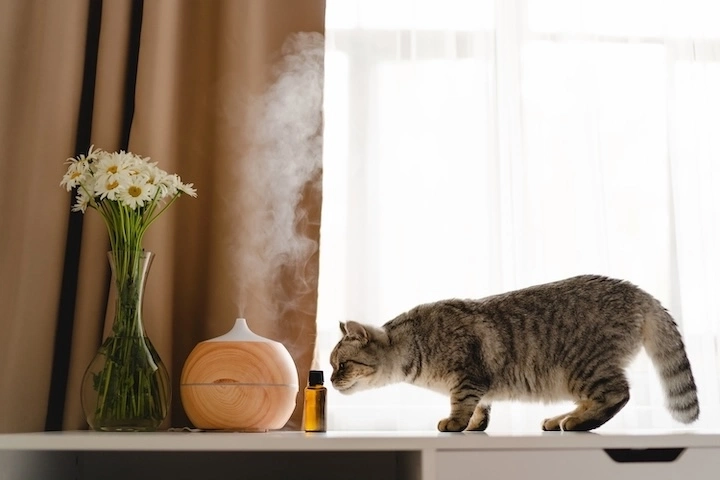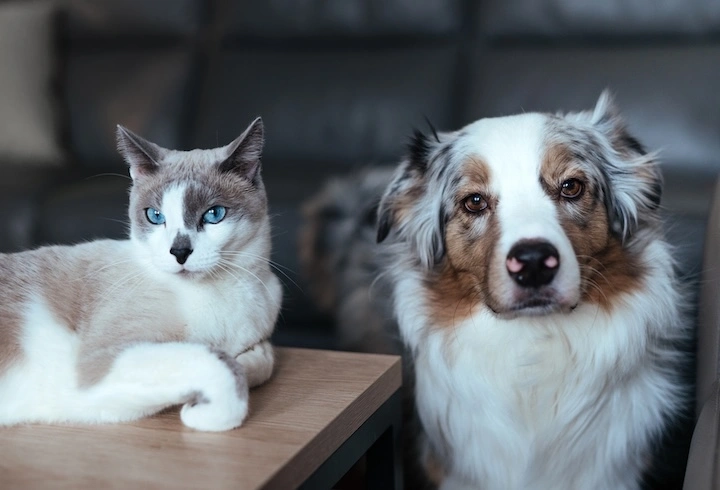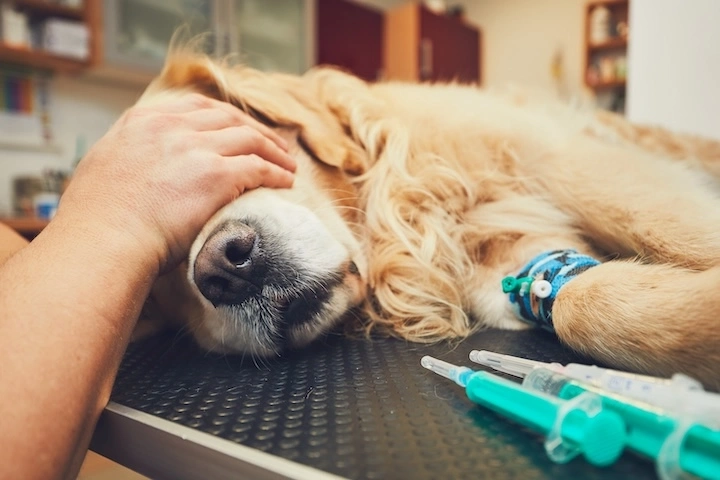
13 février 2025
Animal aromatherapy: a natural approach to master
Aromatherapy has seen considerable growth in recent years. This natural approach, which uses essential oils for animal wellness, requires special attention. Indeed, dogs and cats do not react the same way as humans to essential oils, and their heightened sensitivity demands thoughtful and adapted use.
Animal aromatherapy represents a specialized branch of phytotherapy, specifically designed to address the particular needs of our pets. This ancestral practice, now supported by modern research, helps support our companions in various situations: stress, anxiety, skin problems, or parasitic issues.
In this guide, we will explore the multiple facets of animal aromatherapy, starting with fundamental principles, before addressing species-specific characteristics and secure usage protocols.
Discover our selection of essential oils on the Landema.com online store.
Fundamentals of animal aromatherapy
Physiological differences between dogs and cats
The first thing to understand is that our four-legged friends possess radically different physiology from ours. Their olfactory system, much more developed than humans', makes them particularly sensitive to odors and aromatic compounds. Dogs have approximately 220 million olfactory cells, compared to only 5 million in humans, while cats have about 67 million.
This major physiological difference implies increased sensitivity to essential oils. Cats, in particular, present an important metabolic peculiarity: their liver lacks certain enzymes necessary for metabolizing many compounds present in essential oils. This characteristic makes them particularly vulnerable to certain molecules, notably phenolic compounds.
Olfactory system particularities
Dogs, although generally more tolerant than cats, also require specific precautions. Their exceptional olfactory sensitivity implies the use of much lower dilutions than those used for humans. Additionally, certain areas of their body, such as paw pads or ears, present significant cutaneous absorption that must be considered during any application.
Specific sensitivities to essential oils
Understanding these physiological particularities is essential for safe essential oil use. It allows for adapting protocols, dosages, and administration methods according to the species concerned. This personalized approach forms the basis of effective and safe animal aromatherapy.

Essential oils suitable for dogs
Dogs show better tolerance to essential oils than cats, but certain precautions remain essential. Rigorous selection of essential oils and adapted dosage ensure safe and effective use.
Safe essential oils
True Lavender (Lavandula angustifolia) stands out as the most versatile essential oil for dogs. Known for its soothing properties, it helps reduce anxiety and promotes restorative sleep. Its gentle action makes it a preferred choice for first-time use.
Roman Chamomile (Anthemis nobilis) essential oil offers similar benefits to True Lavender, with particularly effective action on digestive issues and agitation. Its delicate fragrance is generally well accepted by dogs, even the most sensitive ones.
Tea Tree (Melaleuca alternifolia) essential oil, used with caution and always diluted, can help maintain healthy skin and fight external parasites. However, its concentration should never exceed 5% in preparations.
Recommended applications
For cutaneous use, dilution is crucial:
- Standard dilution: 1 to 2% in a carrier oil
- Application areas: back, chest, tail base
- Frequency: 1 to 2 times per day
For atmospheric diffusion:
- 2-3 drops maximum in a diffuser
- 15-20 minutes of diffusion
- 2 times per day maximum

Essential oils for cats
Cats present particular sensitivity to essential oils due to their specific liver metabolism. Their liver lacks the enzymes necessary to metabolize certain compounds, notably phenols and terpenes.
Special precautions
Feline sensitivity imposes important restrictions:
- Avoid any direct application on the skin
- Prohibit prolonged diffusion
- Use only essential oils specifically validated for cats
Safe alternatives
Hydrosols represent the safest alternative for cats:
- True Lavender hydrosol (Lavandula angustifolia): soothes and relaxes
- Roman Chamomile hydrosol (Anthemis nobilis): aids digestion
- Damask Rose hydrosol (Rosa damascena): emotional balance
Other natural solutions can be considered:
- Plant macerates
- Bach flower remedies
- Clays for external application
The golden rule with cats remains extreme caution. When in doubt, it's better to abstain and consult a veterinarian specialized in animal aromatherapy.

Methods of use
Atmospheric diffusion
Diffusion represents a gentle method to introduce essential oils into our animals' environment. For optimal use:
- Diffuse in a well-ventilated room
- Limit session to 15-20 minutes maximum
- Use 2-3 drops of essential oil maximum
- Ensure the animal has access to an exit
The choice of diffuser is crucial:
- Prefer cold diffusers
- Avoid heat diffusers that alter molecules
- Choose quiet devices
Cutaneous applications
Skin application requires rigorous dilution:
- For dogs: 0.5% to 2% dilution maximum
- For cats: prefer hydrosols
- Always use quality carrier oil such as Jojoba (Simmondsia chinensis), gel, or cream.
Recommended application zones:
- Back, between shoulder blades
- Base of tail
- Chest (dogs only)
- Absolutely avoid muzzle and genital areas

Benefits by issue
Stress and anxiety management
To calm a stressed animal:
- True Lavender essential oil (Lavandula angustifolia) in gentle diffusion
- Roman Chamomile essential oil (Anthemis nobilis) in local application (dogs only)
- Sandalwood essential oil (Santalum austrocaledonicum) in occasional diffusion
Recommended protocols:
- Short sessions of 10-15 minutes
- Application before stressful situations
- Possible renewal every 4-6 hours
External parasite control
Natural preventive solutions:
- Geranium essential oil (Pelargonium graveolens) in 1% dilution
- Citronella essential oil (Cymbopogon winterianus) (dogs only)
- Lavandin super essential oil (Lavandula intermedia super) in localized application
Repellent formulas:
- Mixture of maximum 3 essential oils
- Weekly application during risk periods
- Always combine with other preventive measures
Digestive issues and discomfort
To relieve digestive problems:
- Ginger essential oil (Zingiber officinale) in gentle massage and/or diluted and dispersed on kibble (dogs only)
- Peppermint essential oil (Mentha x piperita) diluted and dispersed on kibble (dogs only)
These natural solutions should always be part of a global approach to animal wellness, complementing balanced nutrition and appropriate physical activity.
Find other advice in the article "Veterinary aromatherapy: a practical guide to essential oils for animal wellness".

Essential precautions and contraindications
Using essential oils with animals requires particular vigilance. Some essential oils, although beneficial for humans, can prove dangerous for our four-legged companions.
Essential oils to absolutely avoid
- Essential oils rich in phenols: Oregano (Origanum vulgare), Thyme with thymol (Thymus vulgaris), Clove (Eugenia caryophyllus)...
- Essential oils rich in ketones: Atlas Cedar (Cedrus atlantica), Spearmint (Mentha spicata), Rosemary camphor (Rosmarinus officinalis camphoriferum), Rosemary verbenone (Rosmarinus officinalis verbenoniferum), Common Sage (Salvia officinalis)
- Mentholated essential oils, pine, and Tea tree (Melaleuca alternifolia) for cats
Risk situations
- Pregnant or nursing females
- Animals under 6 months
- Elderly or sick animals
- Epileptic or cardiac animals
Intolerance signs to monitor
- Sudden behavioral changes
- Breathing difficulties
- Skin irritations
- Digestive issues
- Unusual lethargy
If these symptoms appear, it is imperative to immediately stop using essential oils and consult a veterinarian.
To learn more, also read "Veterinary aromatherapy: a practical guide to essential oils for animal wellness".
For successful animal aromatherapy
Discover our selection of essential oils on the Landema.com online store.
Aromatherapy offers a promising natural approach for our pets' wellness. However, its use requires precise knowledge and great caution. The key to successful aromatherapy lies in respecting dosages, careful observation of the animal's reactions, and prior consultation with a professional.
Always prioritize essential oil quality and start with very low dilutions. Remember that each animal is unique, and what suits one may not suit another.
Items that could
interest
Our essential oils
will simplify your life
FAQ
As a customer of the Landema website, did you know that we also have a physical store? If you live in the Landes, in New Aquitaine or are planning to stay there, do not hesitate to visit us! We are located in Le Sen, on the Biolandes site, very close to Labrit, Roquefort, and Mont-de-Marsan, in the heart of the Landes de Gascogne regional natural park.
Essential oils are natural aromatic substances extracted from plants. They are often used in aromatherapy for their health and wellness benefits. Essential oils can be extracted from different parts of plants, such as leaves, flowers, barks, roots or seeds. The use of essential oils dates back to ancient times, where they were used for their medicinal properties and to perfume cosmetics and skincare products.
Landema invites you to discover our product range composed of essential oils, absolutes, vegetable oils, macerates or hydrosols. Our catalog will grow over time, stay informed by subscribing to our newsletter.
We invite you to discover our practical guides and our blog where you can discover our advice and our cases of use of essential oils.
Your wishlist
You must be logged in to post a comment.
Login, or create an account
There is no comment for this article yet